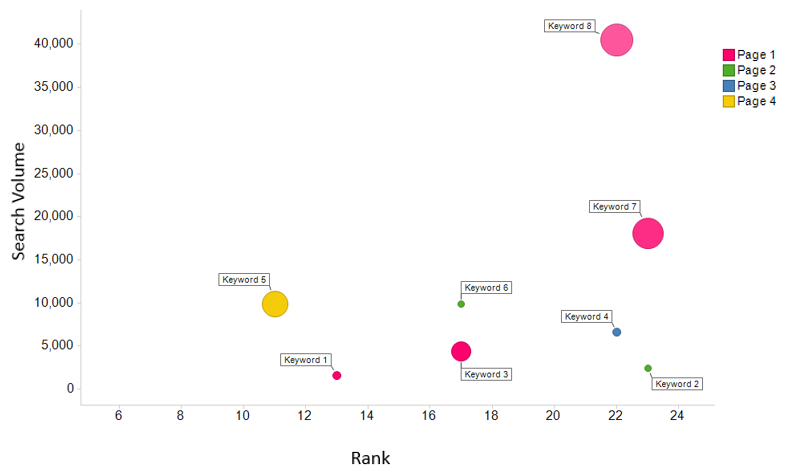Easy Wins for Your Website
November 13, 2014When developing a keyword strategy for a website it’s easy to look at basic keyword research (search volume, competition and trends) and stop there. Unfortunately, when you just look at these basic factors, a lot of opportunity is missed.
One great insight that is often overlooked is current site rankings. I’m not referring to traditional ranking tools where you input your keywords and it tells you where you rank. I am referring to more advanced tools such as Data Cube, which is a part of BrightEdge. In Data Cube all you need to do is input a URL and it will return every keyword the site ranks for, including search volume and the specific landing page. After you have your export you should also layer in competition from the Google keyword planner tool. This is a great way to uncover low hanging fruit you may be ranking on and didn’t even know.
Additionally, having it broken out by landing page is a great benefit. A lot of the time I see that the same landing page will be ranking in the low-hanging-fruit range for multiple keywords. The reason this is important is because it highlights a need for more pages. In exercising a one-to-one keyword-to-page mapping, you want to avoid updating a page in an attempt to improve on all keywords it ranks on. Instead, the best approach is to focus the page on the best keyword (highest search volume, competition, right to win, etc.). After you have chosen which keyword to target for the page, the next step is to analyze the other keywords that are ranking on that page to determine if a new page should be created for each one.
Here we take a look at a top CPG company’s website rankings compared to search volume. Each plot on this graph represents a keyword and is colored by the landing page that ranks for that keyword. What this is showing us is that there are four keywords that are low hanging fruit for page 1, two keywords for page 2 and one each for both pages 3 and 4.
***The larger the circle the lower the competition. This was done to emphasize the biggest opportunities
Based on this information we can now come up with an action plan. Below is a breakdown of each landing page. In this example we will assume none of these four pages have a keyword ranking in the top five positions. If they did, we would only be evaluating if we need a new page for the low hanging fruit.
Page 1: This is the scenario I see most often while conducting this research. We have four keywords that all qualified as low hanging fruit—1, 3, 7 and 8—and they are all ranking on the same page. We won’t be able to get this page to a point where it ranks in the top three positions for all four terms, so what do we do?
The first thing I notice is there is a glaring opportunity with keyword 8. It has the highest search volume and the lowest competition. I will be refocussing Page 1 solely on keyword 8. We now have keywords 1, 3 and 7 left. This is where we need to look at each keyword and determine if it is worth creating new content for them. It appears it would be worth the effort for keyword 7 based on the search volume and competition. Keyword 1 might not be worth it, given strong competition and lower search volume; however with a ranking of 13 there is still a good chance of getting a top spot. Keyword 3 is similar. Here I would look at how optimized page 1 is for that keyword to see how realistic it is to win on it with a new, fully optimized page.
Page 2: Keywords 2 and 6 both rank on this page and have strong competition. Again, more in- depth analysis is needed. In order to determine which keyword to go after, you will need to ask the following questions:
- Have we peaked on these terms? It may be possible the competition is too strong and we should go another route.
- Which keyword is this page more likely to win on?
- Is the keyword we didn’t choose important enough to us to create a new page?
- Would we win on it if we create a new page?
Page 3: Keyword 4 is the only keyword ranking for this page. Competition is strong here so again we need to decide if we are fully optimized, and whether we have peaked on this term or we can realistically win with some adjustments. With such strong competition I would only pursue it if this page was not optimized at all for the term. If the page is not optimized, then the strong ranking tells me Google is begging me to have this optimized and I’m going for it.
Page 4: This is pretty simple. Keyword 5 is the only keyword in the low hanging fruit realm for this page. It also has little competition. We should be able to obtain a top three ranking with minimal effort. This may include refreshing the meta data, a few tweaks to the content, some updated tagging and maybe a push on social media.
In conclusion there are most likely several easy wins for your website you may not have noticed. Using tools such as Data Cube can help uncover this low hanging fruit and provide some quick and easy wins for your website. Just make sure you focus each page on only one keyword so you don’t dilute your search efforts.




